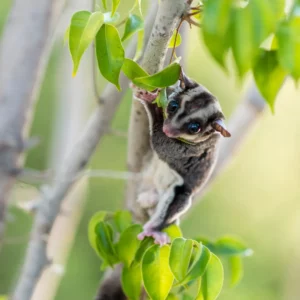Blog
Sugar Glider Treat Bowl: A Nutrient-Packed Homemade Delight
Elevate your sugar gliders’ treat time with a homemade, healthy treat bowl crafted with love. In this culinary journey, we’ll guide you through the creation of a delightful bowl featuring hydrating watermelon, cantaloupe, honeydew, a touch of pure maple syrup for natural sweetness, and protein-rich hard-boiled eggs. This irresistible combination not only satisfies their taste buds but also provides essential hydration, vitamins, and nutrients for their overall well-being. Click here to watch our visual representation.
Crafting the Perfect Treat Bowl:
Let’s delve into the key ingredients that make this DIY treat bowl a nutritional delight:
Watermelon, Cantaloupe, Honeydew:
Start with a refreshing blend of fresh fruits, including watermelon, cantaloupe, and honeydew. These fruits provide hydration and essential vitamins crucial for your sugar gliders’ health.
Pure Maple Syrup:
Introduce pure maple syrup as a natural sweetener, adding flavor to the treat bowl. However, offer it in moderation due to its sugar content, ensuring a balance that complements the other ingredients.
Hard-Boiled Egg:
Enhance the protein content with hard-boiled eggs, offering a protein-rich option that supports muscle development and provides overall nutrition.
Toxic Foods For Sugar Gliders:
Sugar gliders are exotic pets with specific dietary requirements, and certain foods that are safe for humans can be toxic to them. Here’s a list of common toxic foods:
Chocolate: Contains theobromine, which is toxic and can lead to serious health issues.
Caffeine: Found in coffee, tea, and some soft drinks, caffeine can be harmful and cause adverse reactions.
Alcohol: Any form of alcohol is toxic and can result in severe health consequences.
Onions and Garlic: These vegetables contain compounds that can lead to anemia and other health problems.
Citrus Fruits: Citrus fruits are acidic and can cause digestive issues.
Avocado: Contains a substance called persin, which is toxic to many animals.
Pits and Seeds: Seeds or pits from fruits like cherries, peaches, and apricots can be toxic due to cyanide content.
High-Fat and High-Sugar Foods: Foods high in fat and sugar can lead to obesity, diabetes, and other health problems.
Salty Foods: Excessive salt can lead to dehydration and kidney issues.
Dairy Products: Sugar gliders are lactose intolerant, and consuming dairy can result in digestive upset.
Processed or Junk Foods: Foods high in preservatives, additives, and artificial ingredients are not suitable.
Raw Meat and Raw Eggs: Can carry the risk of bacterial contamination and should be avoided.
Customizing for Your Sugar Gliders’ Needs:
Remember, proportions matter when tailoring this treat bowl for your pets. Consider factors such as age, weight, activity level, and health condition. Adjust the quantities of each ingredient to create a bowl that suits their unique nutritional requirements.
Why Proportions Matter:
Taking charge of your sugar gliders’ diet allows you to create a treat bowl that addresses their individual needs. Maintaining the right balance ensures they receive the necessary nutrients without excess, promoting optimal health and well-being.
Conclusion:
Embark on the journey of creating a customized treat bowl, a gesture of love that goes beyond standard treats. Tailor the ingredients to suit your sugar gliders’ unique requirements, and observe their delight as they indulge in this nutritious feast. By taking the time to craft a wholesome treat bowl, you not only show affection but also contribute to their overall health and happiness. So, gather the ingredients, customize the proportions, and treat your adorable companions to a delightful and health-conscious treat bowl today!



